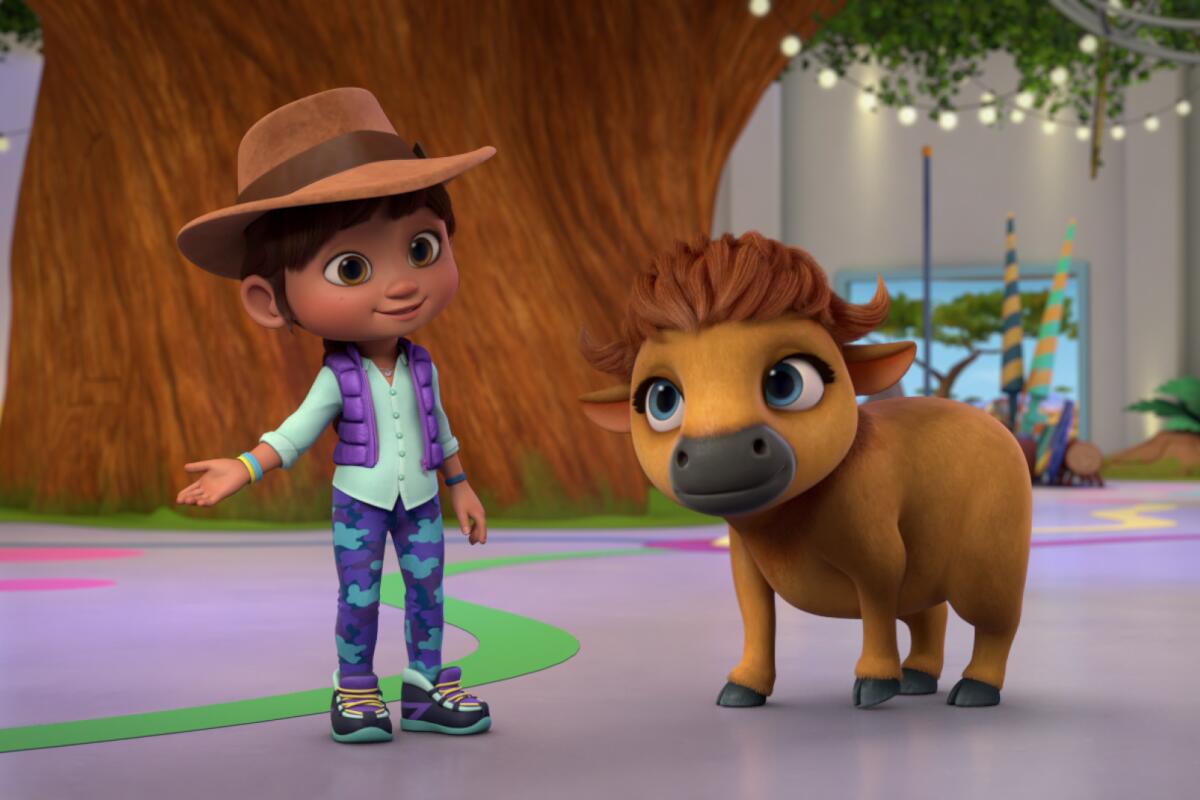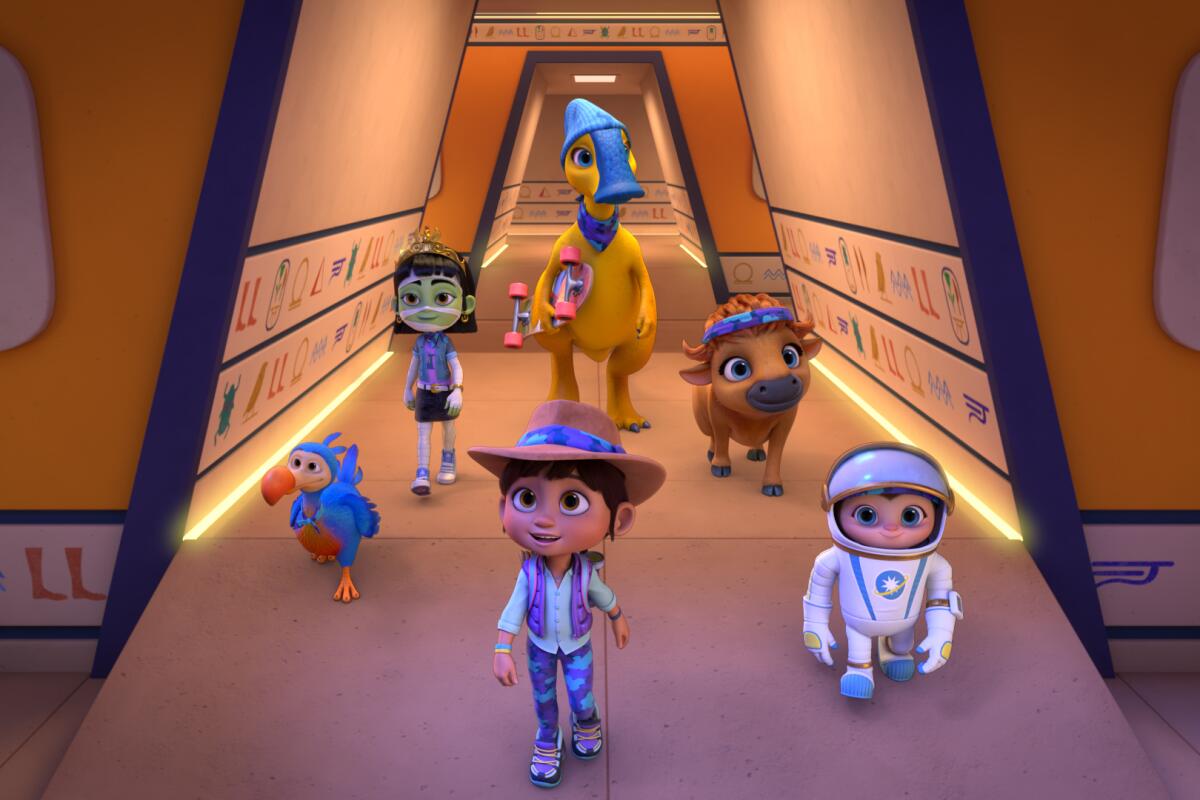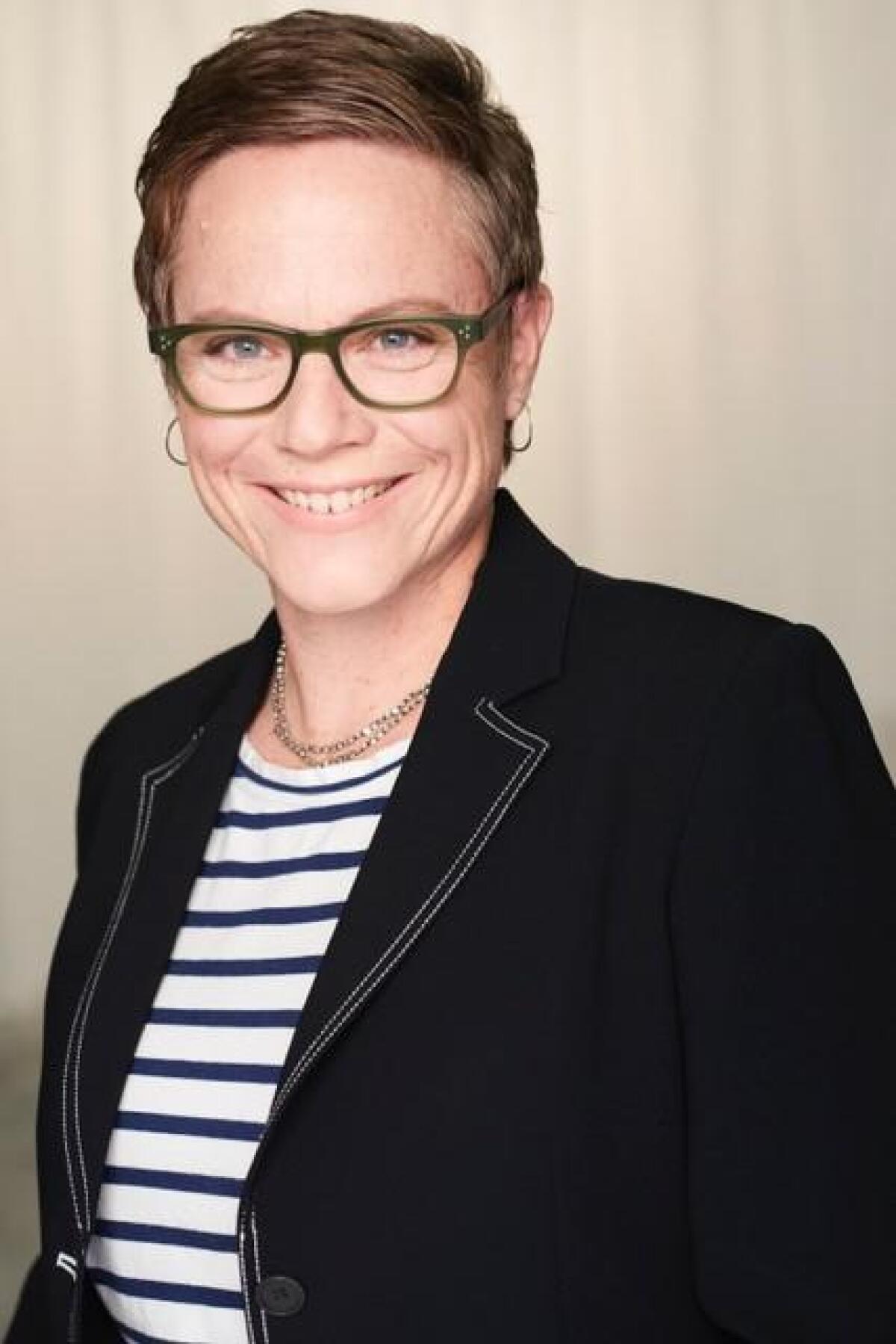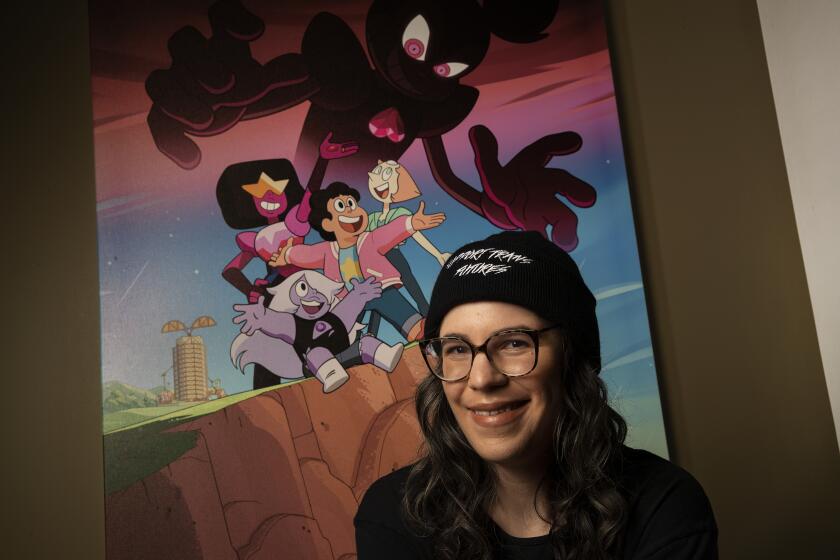As outcry over Chappelle continues, an LGBTQ pioneer returns to Netflix

- Share via
Fred, the bison on Netflix’s animated preschool series “Ridley Jones,” is in many ways typical of the adorable characters that populate programs aimed at the 6-and-under set: They love to dance, sing and help out their friends.
But Fred is groundbreaking too. Voiced by nonbinary actor Iris Menas, the bison is the first nonbinary series regular on a preschool television program.
“Ridley Jones,” which returns for a second season Nov. 2, follows 6-year-old Ridley (voiced by Iara Nemirovsky), who lives with her mother (Sutton Foster) and grandmother (Blythe Danner) inside a museum. At night, all the exhibits come alive: In addition to Fred, there’s Dante the dinosaur (Tyler Shamy), Dudley the dodo (David Errigo Jr.), Peaches the astronaut chimp (Laraine Newman) and Ishmat the girl mummy (Ashlyn Madden).
For executive producer and creator Chris Nee, telling this story is very personal. “In creating the character of Fred, I was very aware that we were in a moment where the trans and gender-fluid and nonbinary community was in as much direct threat in conversation as I was coming out as gay in 1988,” she says.
The complete guide to home viewing
Get Screen Gab for everything about the TV shows and streaming movies everyone’s talking about.
You may occasionally receive promotional content from the Los Angeles Times.
But “Ridley Jones” returns at a fraught moment for Netflix. The streamer remains embroiled in controversy over Dave Chappelle’s comedy special “The Closer,” which premiered last month and features transphobic language that has sparked outrage both inside and outside the company. On Friday, two Netflix employees filed a complaint with the National Labor Relations Board alleging that the company had unfairly retaliated against them for protesting the special.
More broadly, the reaction to “The Closer” has raised questions about whether it is appropriate for the platform to highlight its support for LGBTQ-friendly programming like “Orange Is the New Black,” “Hannah Gadsby: Nanette” and “Disclosure” while simultaneously offering a home to content that queer advocates say is harmful.
“I haven’t and won’t watch the Chappelle special so I can’t comment on it with specificity,” Nee said in a statement to The Times. “But as always, I stand with my trans brothers and sisters.” (Netflix and Jeremy Blacklow, director of entertainment media for GLAAD, which has condemned the special and Netflix’s response, declined to comment on the Chappelle controversy for this story.)
Still, “The Closer” is out of step with trends in trans and nonbinary representation on television, both at Netflix and more broadly. In particular, Blacklow says, “tremendous strides” have been made in kids and family programming, where positive portrayals of LGBTQ characters have the potential to shape both self-acceptance and what he calls a “pathway to allyship”: “[Children’s] shows are where the most growth needs to take place — and where the most growth is taking place,” he says. “Meeting kids where they are on terms they can understand is your North Star ... presenting things in a matter-of-fact way and showing those lessons of friendship and what acceptance really means.”

Fred is just one emblem of the evolving children’s television landscape. An episode during the first season of Netflix’s “The Baby-Sitters Club” had one of the club members caring for a transgender child. Gonzo wears a ballgown in an episode of Disney Junior’s “The Muppet Babies.” Menas also voiced the nonbinary character Odee the Okapi in one episode of DreamWorks’ “Madagascar: A Little Wild.”
When GLAAD added the category of kids and family programming to its GLAAD Media Awards in 2018, Blacklow said there was concern that there might not be enough shows to fill the nominations. Today, the pool to choose from is so large that GLAAD added a second category, children’s programming, which covers shows specifically aimed at younger children.
There was a time when networks and streaming platforms, fearing the wrath of groups like One Million Moms, might have stayed away from the introduction of a nonbinary bison. But by and large, Blacklow says, “Media companies stopped being scared”: “I do not see [‘Ridley Jones’] as a blip. I don’t think there’s any going backwards at this point. I think there’s only a pathway to more inclusiveness.”
The nonbinary revolution has come to TV. But writers, actors and advocates say excitement over numbers is “foolish” if it doesn’t come with creative power.
Blacklow credits this “sea change” to the decades of struggle by people inside and outside the industry. “On a macro level it may have been accelerated by everything that happened by the election of Donald Trump and the #MeToo movement. There was a great reckoning in our country around those years in a way that has led to more and better change.”
That doesn’t mean the struggle is over, though: “We will still need much more of the full intersectional representation of the full queer community across children’s programming,” Blacklow says. “Making sure we show queer people from every walk of life, all races and gender identities and abilities and nationalities and body types and immigrant status and everything.”
In this, “Ridley Jones,” like Nee’s other series, is a model: Ridley is a female action hero, and Ishmat has two dads (voiced by Andrew Rannells and Chris Colfer); both “Doc McStuffins,” which Nee created for Disney Junior, and “Ada Twist, Scientist,” streaming on Netflix, are led by Black heroes. “I’m always very interested in characters who feel othered,” Nee says. “Those who are struggling to be perceived on the outside as they feel they are on the inside.”
Nee engages in “the opposite of colorblind casting” to ensure that the performers match the characters they play onscreen. To Menas, who uses zie/hir pronouns, this casting protocol is of profound importance. “I have worked with trans youth groups,” Menas says. “And the most common thing I hear from the kids is, ‘I didn’t know trans adults existed.’ To see a real live nonbinary trans person behind the voice of Fred has a life-changing impact on those children.”

Having an animated animal be the nonbinary character opens up the teachable moment. “We all as humans have preconceived ideas of what gender is and what gender looks like,” Menas says. “I think it’s a really interesting tool to use an animal because we have nothing to project on an animal in terms of gender. You can’t know what gender an animal is by looking at it. There’s something so beautiful about boiling something down for a child to understand.”
In the second season, Fred gets a big storyline as they grapple with what they’re going to wear to a dance. Ishmat thinks Fred wants a fancy dress but Fred longs to wear a powder-blue tuxedo. When Fred finally dons the snazzy attire of their dreams, they break into a song aptly titled “I Feel Like Me.”
“The blue suit may or may not very much resemble a powder-blue suit that I had when I was young,” Nee laughs. “It’s a story of Fred saying, ‘I was afraid because something I wanted was different and that you guys wouldn’t support me.’”
It’s important to reach children during these formative years, says Christy Waterman, a professor of early childhood education at Pacific Oaks College in Pasadena. “Children are just little scientists. From the moment children are born, they’re gathering data. They’re gathering information just to make sense of the world. We don’t always do the best job [of] establishing that different doesn’t mean bad — it just means different.”
“Steven Universe” creator Rebecca Sugar explains why LGBTQ representation was central to the show — and looks back on how it made TV history.
Menas, who can be seen in the upcoming “West Side Story,” didn’t grow up seeing characters like Fred on television. “To have that representation onscreen, I would have felt seen, I would have felt understood, I would have felt like there was a future for me,” Menas says. “I hope when kids see Fred it helps a young child, nonbinary or not, feel less alone, less othered for whatever it is — their sexuality, their gender identity, anything at all. We can all relate to feeling othered in some ways as kids, so I think that’s particularly important. Just to normalize the things that my generation has been taught are bad or wrong.”
Seeing gay, transgender or nonbinary characters on their favorite TV shows isn’t important just for children who may see themselves onscreen but also for their peers. At one point Ridley says to Fred, “That’s exactly why we love you, Fred. Because you’re different and not afraid to show it.”
Fred wants to be known as big and tough, but they’re also the one who orchestrates a romantic dinner for the show’s meerkat couple. The dance episode is just one of the deeper Fred stories told in the show’s second season. “We start to really do justice to unrepresented groups when they get to have the whole range of being human,” Nee says. “I’m complicated to the nth degree and so is Fred.”
‘Ridley Jones’
Where: Netflix
When: Anytime (new season starting Tuesday)
Rating: TV-Y (suitable for young children)
More to Read
The complete guide to home viewing
Get Screen Gab for everything about the TV shows and streaming movies everyone’s talking about.
You may occasionally receive promotional content from the Los Angeles Times.







